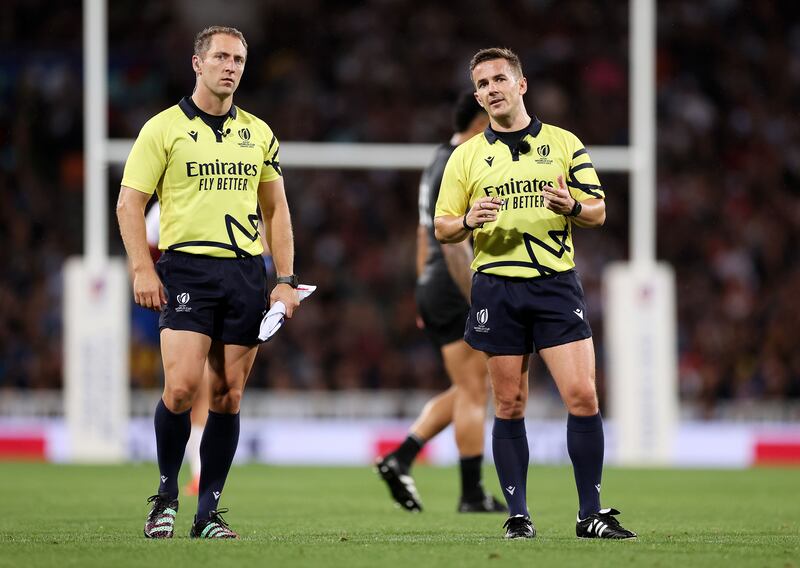Louis Rees-Zammit, Harry Mallinder and Darragh Leader, rugby players trying their hand at the NFL, aren’t the only developing links between the oval ball and the gridiron.
Sunday’s AFC championship game featured a master vs apprentice coaching matchup. Andy Reid, head coach of the Kansas City Chiefs, lined up against his former assistant, John Harbaugh who has long been in charge of the Baltimore Ravens.
Their link is labelled a coaching tree, a line of current head coaches who trace their lineage back to working under a common, older guru. In this year’s NFL regular season, three of the eight division winners were coached by members of Reid’s coaching tree, four if you include Reid himself and the Chiefs.
In rugby, we don’t speak of coaching trees in the same way but a substantial, Irish-tinged one is fast developing.
READ MORE
According to reports in South Africa, former Ireland hooker Jerry Flannery is being lined up as the Springboks’ defence coach. The man he is replacing is starting to look like the head of his own distinguished coaching tree.
Jacques Nienaber was technically the Boks’ head coach, but defence was his remit. Flannery worked with Nienaber when both were previously on Munster’s coaching ticket.
Last week, Flannery, Harlequins’ defence coach, was quoted in the English press as saying Nienaber was “the best coach I’ve ever come across.”
Flannery also spoke about mimicking Nienaber and South Africa’s aggressive blitz defence. The Irishman has tried to add some South African-style defence to complement their attacking flair, speaking about outside wingers who can fly out of the line while also having the speed to recover out wide.
Flannery’s experience with Nienaber renders any potential Springbok appointment eminently sensible. Lest we forget Felix Jones, another former Nienaber disciple at Munster and South Africa, now working with England.

France vs Ireland preview with Gordon D'Arcy and Noel McNamara
With Nienaber himself at Leinster, Jones at England and Flannery (potentially) with the ‘Boks, all coaching defence in the style of the back-to-back World Cup-winners, it’s hard to find a more influential coaching tree.
Wins for Irish teams in Celtic Challenge
A strong day for the two Irish sides in the Celtic Challenge saw the Clovers and the Wolfhounds defeat Scottish opposition on Saturday.
The day’s first game saw the Clovers defeat Glasgow Warriors 10-29 away in Scotstoun Stadium. A comprehensive first half display featuring tries from Méabh Deely, Dorothy Wall, Beth Buttimer and Ivana Kiripati saw the Irish side race into a 5-24 half-time lead. This was despite a yellow card for scrumhalf Abbie Salter-Townshend who hadn’t retreated 10m off a quickly-taken penalty.
Glasgow could not score with a player advantage but did strike back just before the break to break their duck on the scoreboard.
In the second half, both sides exchanged a solitary try, the Clovers’ coming from Brianna Heylmann, to leave the Irish side with a 19-point winning margin.
In the evening game, the Wolfhounds had a far more comprehensive 41-10 victory over Brython Thunder at the Kingspan Stadium.
Wolfhounds didn’t open the scoring until the 24th minute when Old Belvedere’s Brittany Hogan crossed. The Thunder hit back seven minutes later but Amy Williams’ missed conversion ensured the Wolfhounds remained in the lead.
Further first half scores were added by Sarah Delaney and Katie Corrigan to leave the half-time score at 17-5.
However, it was in the second half where the most significant damage was done, winger Corrigan adding a further three tries – leaving her with four in the match – an effort from fellow wing Niamh Marley as the Thunder were blown away.
Bunkered up
The TMO bunker review system, front and centre during the World Cup, will once again be in use during the Six Nations.
The new structure largely worked well in France, reducing the time taken by the TMO in the stadium when reviewing foul play, expediting it instead to whoever was in the bunker away from the cut and thrust of a cauldron atmosphere.
That is the point, however. During the World Cup, we did not know the identity of who was in the bunker. The anonymity will continue in the Six Nations.
In an era of abuse on social media and criticism from frustrated players in press conferences, perhaps the powers that be want to protect who they can. On broadcasts, we hear the in-person TMO communicate the decision of the TMO bunker to the referee – we only hear two voices, not three.

No one wants to exposé more people to abuse. You can be sure whoever is in the bunker is privately held accountable by extensive in-house reviews. Yet the bunker is not publicly accountable in the same way as the referee, assistants and TMO.
When the bunker adjudicates exclusively on foul play decisions, and therefore on game-defining cards and their colour, this accountability discrepancy is hard to swallow.
In numbers
101 – The combined points total in Bristol’s scintillating 57-44 victory over Bath on Saturday.
In words
“I also learned with around one hour’s notice that Louis Rees-Zammit had decided to leave rugby union to try out for the NFL. I just had to laugh, telling myself that there also is never a dull moment in Welsh rugby.” – Writing in The Telegraph, Warren Gatland seemed in good spirits about the ‘timely’ news he was losing his best young back for the Six Nations.
- Sign up for push alerts and have the best news, analysis and comment delivered directly to your phone
- Find The Irish Times on WhatsApp and stay up to date
- Our In The News podcast is now published daily – Find the latest episode here















